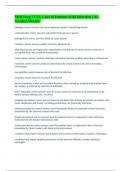Med-Surg I C23: Care of Patients With Infection || A+
Graded Already.
pathogen correct answers any microorganism capable of producing disease
communicable correct answers transmitted from person to person
pathogenicity correct answers ability to cause disease
virulence correct answers another term for pathogenicity
what three factors are required for transmission of an infection? correct answers reservoir, a
susceptible host, and a mode of transmission
toxins correct answers protein molecules released by bacteria to affect host cells at a distant site
exotoxins correct answers produced and released by certain bacteria into the surrounding
environment
susceptibility correct answers risk of the host for infection
immunity correct answers resistance to infection
passive immunity correct answers short duration; either natural by transplacental transfer from
the mother, or artificial by injection of antibodies
active immunity correct answers lasts for years, natural by infection or by stimulation of the
body's immune defenses (ex. vaccines)
standard precautions correct answers based on the belief that all body excretions, secretions, and
moist membranes and tissues, excluding perspiration, are potentially infectious
airborne precautions correct answers used for patients known or suspected to have infections
transmitted by the airborne transmission route
droplet precautions correct answers used for patients known or suspected to have infections
transmitted by the droplet transmission route
contact precautions correct answers used for patients know or suspected to have infections
transmitted by direct contact with items in the environment
conditions that require airborne precautions correct answers tuberculosis, measles, chickenpox
conditions that require droplet precautions correct answers influenza, mumps, pertussis,
meningitis
, conditions that require contact precautions correct answers MRSA, VRE, lice, scabies, RSV, C.
difficile
cohorting correct answers the practice of grouping patients who are colonized or infected with
the same pathogen
innate immunity correct answers aka natural or native immunity - provides immediate, short-
term, and non-specific defenses against foreign antigens
normal flora correct answers a group of generally non-disease causing microorganisms found in
various areas of the body, including the respiratory & GI tract, integument & urethra
beneficial effects of normal flora correct answers secrete & excrete vitamins, facilitate
production of IgG, inhibit pathogenic colonization, inhibit or destroy microorganisms that are not
flora bacteria
deleterious effects of normal flora correct answers sometimes assists pathogens to survive by
sharing growth factors or vitamins, absorb host nutrients for own needs, serve as potential
pathogens when they gain entrance to areas they do not belong
external barriers correct answers intact skin & mucous membranes, secretions, enzymes,
phagocytic cells, nasal hair and lung cilia, lysosomes, normal flora, gastric pH
internal barriers correct answers inflammatory response, WBCs, phagocytic cells, NKCs, serum
complement, interferon
what are the three responses of inflammation? correct answers - vascular response, cellular
response, exudate formation and repair
what happens during the vascular response? correct answers blood vessels dilate, fluid leaks
from surrounding cells, WBCs migrate to area & promote edema, histamines released from
injured cells = increased capillary permeability
what happens during the cellular response? correct answers inflammatory cells and their products
act @ site of injury, kill microorganisms, confine damage, remove debris, and prepare for
healing
what happens during exudate formation and repair? correct answers filling in and sealing of
wound, primary or secondary intention
neutrophils make up _____ of all WBCs correct answers 55-70%
lymphocytes make up ______ of all WBCs correct answers 20-40%
monocytes make up _______ of all WBCs correct answers 2-8%




